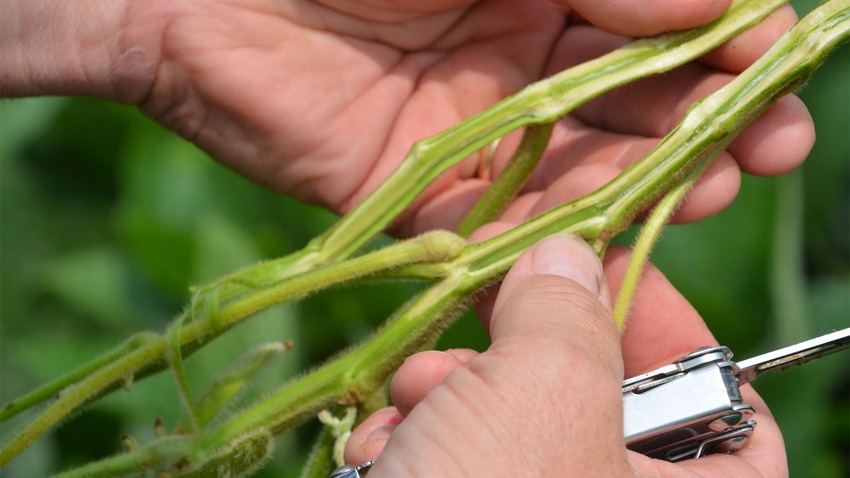
You know what to do when you find a dying plant in your soybean field. You dig it up carefully to check roots, then cut open the stem to see if it’s brown inside. You are looking for clues to identify what went wrong. If it’s a disease, you want to identify which disease.
But what about plants that look healthy? Should you give them a checkup? Steve Gauck says yes, adding that you can compare this practice to an annual physical for people. You want to make sure a plant is as healthy as it looks. One way to do so is by examining it inside and out.
“I like to dig up a few healthy plants and check roots, then split open stems,” explains Gauck, a regional manager for Beck’s, based near Greensburg, Ind. Becks sponsors Soybean Watch ’23.
“Normally, if a plant looks healthy, stem tissue inside will look healthy, firm and free from brownish discoloration,” he adds.
What if the stem doesn’t look healthy inside? “Then we try to determine if it’s a disease issue, and if so, which disease is it?” Gauck explains.
Possible culprits
Here are some common causes of brown discoloration or less-than-healthy conditions inside a soybean stem. Gauck referred to the 2023 edition of the Purdue Corn and Soybean Field Guide for information related to diseases.
Brown stem rot. The pith or center material of the stem turns brown, but the cortex, or outer inside portion, looks normal. If there are foliar symptoms, they are like sudden death syndrome, but one strain of the fungus only causes stem symptoms. Splitting stems and checking for discoloration is key to diagnosing this disease, Gauck says. Some varieties are less susceptible to brown stem rot.
Sudden death syndrome. Yellow, interveinal leaf chlorosis is often the first telltale sign of SDS infection, Gauck says. Split the stem open, and if it is SDS, you will see the reverse of brown stem rot. The pith appears normal, but the cortex has gray and brown streaks, especially in the lower part of the stem. There are varietal differences in susceptibility to SDS, but management practices, like avoiding soil compaction and not planting in cool, wet soils, may help.
Charcoal rot. Small, black specks appear just below the surface of both roots and the lower stem. These microsclerotia allow the fungus to survive in the soil. Early infection can be confused with rhizoctonia, but lesions are not sunken. Dry, hot weather late in the season favors charcoal rot. Some varieties are less susceptible.
Phytophthora root rot. Leaves and stems wilt above ground, and roots rot below ground. The lower stems will turn black. Disease-resistant varieties are available, but you may need to get down to the fungal race level to get genetics to fend off the disease. Seed treatments can help manage this disease.
White mold. Also known as sclerotinia stem rot and more common in northern areas, black sclerotia develops inside the stem. Black sclerotia and fluffy white fungal growth also develop outside the stem. Some varieties are less susceptible, but control may require changes in management.
About the Author(s)
You May Also Like




